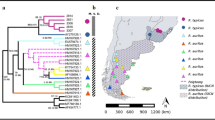Abstract
Based on new material of the rodent genus Pseudotheridomys from the lower Miocene fissurefilling of Schaffhausen near Harburg (Nördlinger Ries, Bavaria) the process of continuous development from Pseudotheridomys to Ligerimys can be demonstrated. Within homogeneous populations of Pseudotheridomys the origin of a new morphotype can be observed. In following populations from several biostrati-graphic levels in southern Germany this type becomes more and more dominant, up to homogeneous populations of Ligerimys florancei. For this example of microevolutionary origin of a new genus — for a long time separated from its forerunner by a large gap in documentation — it is shown that neither a dichotomy nor any special mechanism of macroevolution nor a speciation in the sense of punctualism is necessary to explain its development. The process continued for at least 3 million years. It quite corresponds to the synthetic theory of evolution.
Kurzfassung
Neues Material der Nagetiergattung Pseudotheridomys aus der untermiozänen Spaltenfüllung Schaffhausen bei Harburg (Nördlinger Ries) ermöglicht es, den Prozeß der kontinuierlichen Gebißumwandlung von Pseudotheridomys parvulus zu Ligerimys florancei in einer einheitlichen Entwicklungsreihe zu belegen. An zeitlich aufeinanderfolgenden Populationen kann innerhalb der Gattung Pseudotheridomys die Entstehung eines neuen Morphotyps und dessen zunehmendes Vorherrschen bis zu einheitlichen Populationen von Ligerimys florancei verfolgt werden. Für dieses Beispiel ergibt sich, daß es zum Verständnis der Entstehung der neuen Nagetiergattung weder einer Dichotomie noch eines besonderen makroevolutiven Mechanismus noch einer kurzfristigen Speziation im Sinne des Punktualismus bedarf. Der über mindestens 3 Millionen Jahre andauernde Prozeß — infolge einer großen Dokumentationslücke lange unbekannt — entspricht voll den Vorstellungen der Synthetischen Theorie der Evolution.
Similar content being viewed by others
Literatur
Bettenstaedt, F. (1962): Evolutionsvorgänge bei fossilen Foraminiferen. - Mitt. Geol. Staatsinst. Hamburg,31: 385–460, 18 Abb.; Hamburg.
Bruijn, H. de;Meulen, A. J. v. d. &Katsikatsos, G. (1980): The Mammals from the Lower Miocene of Aliveri (Island of Evia, Greece). Part 1. The Sciuridae. - Proc. Kon. Nederl. Akad. Wet. Ser. B,83 (3): 241–261, 2 Abb., 4 Taf.; Amsterdam.
Daams, R. (1981): The Dental pattern of the DormiceDryomys, Myomimus, Microdyromys andPeridyromys. -Utrecht Micropaleont. Bull., Spec. Publ.,3: 105 S., 36 Tab., 42 Abb., 5 Taf.; Utrecht.
Dehm, R. (1939): Über neue tertiäre SpaltenfüTllungen im Fränkischen und Schwäbischen Jura.- Zbl. Miner. etc., Abt. B,1939 (4): 113–124, 4 Abb.; Stuttgart.
— (1950): Die Nagetiere aus dem Mittel-Miozän (Burdigalium) von Wintershof-West bei Eichstätt in Bayern. - N. Jb. Miner. etc., Abh.,91 (Abt. B): 321–428, 6 Tab., 136 Abb.; Stuttgart.
— (1978): Neue tertiäre Spaltenfüllungen im süddeutschen Jura. - Mitt. Bayer. Staatsslg. Paläont. hist. Geol.,18: 289–313, 4 Abb.; München.
Eldredge, M. &Gould, S. J. (1972): Punctuated Equilibria: An Alternative to Phyletic Gradualism. - [In:] Schöpf, T. J. M. (Hrsg.): Models in Paleobiology: 82–115, 10 Abb.; San Francisco (Freeman, Cooper & Co.).
Fahlbusch, V. (1968): Neue Eomyidae (Rodentia, Mamm.) aus einer aquitanen Spaltenfüllung von Weißenburg in Bayern. - Mitt. Bayer. Staatsslg. Paläont. hist. Geol.,8: 219–245, 9 Abb., 2 Taf.; München.
— (1970): Populationsverschiebungen bei tertiären Nagetieren, eine Studie an oligozänen und miozänen Eomyidae Europas. - Abh. Bayer. Akad. Wiss.,Math.-naturw. Kl., N. F.145: 1–136, 42 Abb., 26 Tab., 11 Taf.; München.
— (1976): Report on the International Symposium on Mammalian Stratigraphy of the European Tertiary. -Newsl. Stratigr.,5: 160–167, 1 Tab.; Berlin/Stuttgart.
— (1979): Eomyidae - Geschichte einer Säugetierfamilie. - Paläont. Z.,53 (1/2): 88–97, 2 Abb.; Stuttgart
— (1981): Miozän und Pliozän - Was ist Was? Zur Gliederung des Jungtertiärs in Süddeutschland. - Mitt. Bayer. Staatsslg. Paläont. hist. Geol.,21: 121–127, 1 Tab.; München.
Fejfar, O. (1974): Die Eomyiden und Cricetiden (Rodentia, Mammalia) des Miozäns der Tschechoslowakei. -Palaeontographica Abt. A,146: 100–180, 35 Abb., 1 Taf.; Stuttgart.
Kahle, H. (1980): Evolution. Irrweg moderner Naturwissenschaft? - 200 S., 29 Abb.; Bielefeld (Nottbeck).
Mayr, H. (1979): Gebißmorphologische Untersuchungen an miozänen Gliriden (Mammalia, Rodentia) Süddeutschlands. - Diss. Univ. München (Fotodruck): 380 S., 18 Taf.; München.
McKenna, M. C. (1975): Toward a Phylogenetic Classification of the Mammalia. - [In:] Luckett, W. P. & SzALAY, F. S. (Hrsg.): Phylogeny of the Primates: 21–46, 3 Abb.; New York (Plenum Publ. Corp.).
Papp, A. (1981): Calibration of Mediterranean, Paratethys and Continental Stages. - Ann. Geol. Pays Hellen. (Proc. VII. Internat. Congr. Mediterr. Neogene, Athens 1979), Hors Ser.4: 73–78, 1 Tab.; Athen.
Rensch, B. (1972): Neuere Probleme der Abstammungslehre. Die transspezifische Evolution. - 3. Aufl.: XI + 468 S., 113 Abb.; Stuttgart (Enke).
Schalk, K. (1957): Geologische Untersuchungen im Ries. Das Gebiet des Blattes Bissingen. - Geologica Bavarica,31: 1–107, 80 Abb., 1 geol. K. 1:25 000, 3 Taf.; München.
Schindewolf, O. H. (1950): Grundfragen der Paläontologie. - 507 S., 332 Abb., 32 Taf.; Stuttgart (Schweizerbart).
— (1969): Über den »Typus« in morphologischer und phylogenetischer Biologie. -Abh. Akad. Wiss. Lit. Mainz, Math.-naturw. Kl.,1969 (4): 55–131, 10 Abb.; Wiesbaden.
Schlee, D. (1971): Die Rekonstruktion der Phylogenese mitHennigs Prinzip. - Aufs. Reden senckenberg. naturforsch. Ges.,20: 62 S., 22 Abb.; Frankfurt a. M.
— (1981): Grundsätze der phylogenetischen Systematik (Eine praxisorientierte übersicht). -Paläont. Z.,55 (1): 11–30, 38 Abb.; Stuttgart.
Schlosser, M. (1884): Die Nager des europäischen Tertiärs. - Palaeontographica,31: 1–143, 18 Abb., 8 Taf.; Cassel.
— (1925 - 1926): Die Säugetierfauna von Peublanc (Dep. Allier). - Soc. Sci. Natur. Croatica,38/39 (Kramberger-Festband): 372–394, 3 Abb., 2 Taf.; Zagreb.
Stanley, S. M. (1979): Macroevolution. Pattern and Process. - 332 S.; San Francisco (Freeman & Co.).
Stehlin, H. G. &Schaub, S. (1951): Die Trigonodontie der simplicidentaten Nager. - Schweiz. Paläont. Abh.,67: 1–385, 620 Abb.; Basel.
Wilder Smith, A. E. (1980): Die Naturwissenschaften kennen keine Evolution. Empirische und theoretische Einwände gegen die Evolutionstheorie. -3. Aufl.: 154 S., 4 Abb.; Basel/Stuttgart (Schwabe).
Willmann, R. (1981): Evolution, Systematik und stratigraphische Bedeutung der neogenen Süßwassergastropoden von Rhodos und Kos/ägäis. - Palaeontographica Abt. A,174: 10–253, 76 Abb., 13 Taf.; Stuttgart.
Author information
Authors and Affiliations
Additional information
Vonrag gehalten beim 10. Symposium des Arbeitskreises Wirbeltierpaläontologie der Paläontologischen Gesellschaft am 12. 3. 1983 in Gwatt/Schweiz.
Rights and permissions
About this article
Cite this article
Fahlbusch, V. Mikroevolution — Makroevolution — Punktualismus Ein Diskussionsbeitrag am Beispiel miozäner Eomyiden (Mammalia, Rodentia). Paläont. Z. 57, 213–230 (1983). https://doi.org/10.1007/BF02990313
Received:
Issue Date:
DOI: https://doi.org/10.1007/BF02990313




